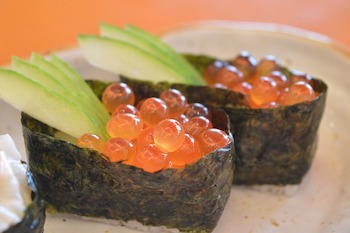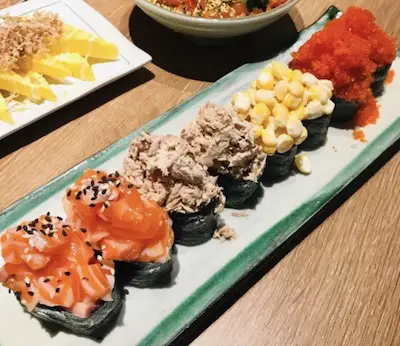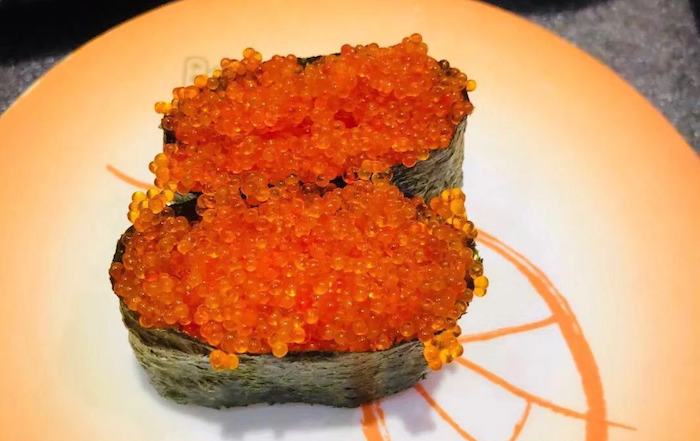We are reader supported. When you purchase through links on our site, we may earn an affiliate commission. Also, as an Amazon affiliate, we earn from qualifying purchases.

Even though it has been more than seven decades since gunkan sushi was invented, there are still some folks out there who either have absolutely no idea what it is, or they know very little about this delicious treat. This is especially the case if you are not Japanese or didn’t grow up eating sushi. Anyhow, there is a first time to everything and certainly to gunkan sushi!
Gunkan is Japanese for warship or battleship. Gunkan Sushi refers to an oval, ship-like sushi roll, comprising a nori seaweed sheet wrapped around a ball of rice with space left at the very top for dressing. The popular toppings are flying fish, salmon or sea urchin roe. However, you may also come across potato salad, negitoro- a mixture of green onion and fatty tuna belly and kaminiso-mixed crab brains garnishes.
Wait, there is more to this delicious little boat! A host of ingredients, recipe and eating etiquette you need to know about if your knowledge is to be complete. So, hang on!
Gunkan Maki – The Battleship Wrapped in Seaweed
To appreciate the nature of gunkan sushi invariably referred to as gunkan maki, it helps to dig a little deeper to understand what maki is. Though classifications vary, there are approximately 12 main types of sushi, maki included, some with variations in between.
Maki
Maki is a Japanese word for wrapped or rolled. Maki sushi is a typical sushi with rice and vegetables, fish or meats as ingredients. All the contents are wrapped in a sheet of nori seaweed and sliced into smaller pieces. As you would expect, human creativity has resulted in lots of Maki variations as listed below.
- Hoso Maki-This is a thin roll
- Chu Maki -This is a medium roll
- Futo Maki- this is a thick roll
- Ura Maki -Instead of the seaweed wrapping the roll, the rice does
- Te Maki- This is a hand-rolled sushi
- Date Maki -This is thick rolled sushi with egg as the wrapper
Gunkan Maki
This is a maki sushi variant invented in 1941 at Ginza Kuybey restaurant. As you would guess, a strip of nori seaweed is wrapped around a ball of rice in a such a way as to leave space at the top for dressing with various ingredients. The striking variation in this maki is its oval shape that looks like a tiny warship. You can find gunkan sushi at sushi restaurants and in takeout sushi bento boxes.
Gunkan Sushi Ingredients and their Nutritional Value
Before you reserve a table at your local sushi joint, it helps to have a thorough knowledge of what exactly makes up this sushi roll and the value the different components add. By now, you must be knowing that Gunkan sushi has four main components.
- The wrapper- made of a Nori Seaweed sheet
- Sushi Rice
- Sweet Rice Vinegar
- Toppings
The Wrapper – Nori Seaweed Sheet
Nori like this is an edible seaweed with a strong, distinctive, ocean flavor. In Japanese cuisine, nori is used in the form of dried sheets to wrap rolls of sushi. The seaweed, scientifically classified as a species of the red alga, is harvested at sea, shredded, and rack-dried into paper-thin, black sheets measuring approximately 18 cm × 20 cm and each weighing 3 grams.
Some gunkan sushi preparers first roast the nori to give it a strong, crispy texture before wrapping it around the sushi rice ball. Most sheets have indented lines on them and this makes it easy for you to cut along the lines giving you uniform strips about 4cm in width. The wrapping is gently but tightly done around the rice so that it glues on the rice.
Apart from being a wrapper, the nori seaweed, usually sold in packs, is loaded with immense nutritional value: It contains:
- Iodine and Tyrosine– One gram of nori seaweed contains 37 mcg of iodine which is about 25% of the recommended dietary intake (RDI). It also contains the amino acid Tyrosine that combines with iodine to aid in the synthesis of triodothyronine (T3) and thyroxine (T4), both of which are thyroid hormones.
- Vitamins and Minerals – the vitamins present are A, B1, B12, C, and E while the minerals are magnesium, sodium, folate, calcium, iron, and omega-3 fats.
- Protective Antioxidants – The flavonoids and carotenoids in nori seaweed play a crucial role in neutralizing free radicals thus lessening their likelihood to damage your cells.
- Fiber and Polysaccharides – these are effective in promoting gut health.
The Sushi Rice
While there is no specific brand of rice recommended for gunkan sushi, the best choice is usually short-grain. Short-grain rice is slightly longer than it is wide. This gives the grains a plump shape. Thanks to the high proportion of amylopectin, a sticky water-soluble polysaccharide, short-grain rice gives gunkan sushi a soft, tender and clumping characteristics.
Sweet Rice Vinegar
This is usually made from fermented rice and has a slightly sweet, mild flavor. The complete sushi seasoning is made up of a mixture of rice vinegar, sugar, and salt known as “Su”. For more information about how to season the cooked rice, please click here
The Toppings
There is a universe of toppings used for gunkan sushi. This is mainly dependent on personal preference and taste: Some of the common ones are:

- Salmon Caviar Ikura – This refers to unfertilized salt-cured salmon eggs. They are fairly high in protein, iron and sodium. Ikura (salmon roe) is deep red in color and the fresh eggs pop when you eat it.
- Capelin Roe Masago(see Amazon) – this is harvested from capelin, a small forage fish found in the Arctic Ocean, North Pacific and North Atlantic. The capelin roe known as masago, is salt cured and has a sweet crunchy flavor. It adds texture and bright color to gunkan sushi.
- Flying Fish Roe Tobiko- Other than masago and ikura, flying fish roe known as tobiko can be used as gunkan sushi garnish. Tobiko is rich in vitamin, protein, and omega-3 acids.
- Goma Wakame Salad – This is seaweed salad containing sesame seeds. It is rich in fiber, antioxidants and low in calories.
See more: https://fitoru.com/tobiko-vs-masago-nutrition-benefits-pros-and-cons/
Other toppings that may be used include corn, carrots, cucumber, quail eggs and Dungeness crab with mayonnaise.
How Gunkan Sushi is Prepared
With the ingredients above set, the process of preparing gunkan sushi is fairly simple. In fact, this maki sushi variant is billed as the simplest to make.
First, you need to cook sushi rice to perfection and then season it with vinegar, sugar, and salt. Find step-by-step instructions here.

Then rice ovals are made each with a width of an inch and a length of two inches. With the nori sheet cut into strips and cucumber sliced into thin moon-shaped discs and arranged at the short end of the rice oval, the rice and cucumber are wrapped into a roll.
The nori sheet is sealed shut on one end and the rice pressed down to create space for garnishes at the top. Before adding the toppings, a little wasabi is sprinkled over the rice oval. The toppings then follow at the very top of the battleship and the sushi served immediately.
How to Eat Gunkan Sushi
In Japanese eating etiquette, you should grip food using a pair of chopsticks. This is the same way you should hold your gunkan sushi. However, as a beginner, you may find it comfortable holding the sushi with your hands as you eat.
There is no need of dipping the gunkan sushi into sauce because the toppings are adequately flavored. However, if you must dip it, you can dip the thin slices of pickled ginger also known as ‘gari’ that are served alongside the sushi until they soak an appropriate amount. Swab the gari onto the gunkan sushi toppings carefully so that you don’t ruin your battleship dressing.
Using the pair of chopsticks gripping the sushi, bring it upright straight to your mouth. Since gunkan sushi is prepared as a one mouth food only, don’t take it in two bites, just one bite and you are done! Ensure the grip is firm so that the toppings do not drop when eating.
While you should not eat gunkan sushi in a rush, leaving it for long can get it sticky and damp. Therefore, don’t let it sit.
Gunkan Sushi is therefore a highly nutritious and delicious sushi variant with super ingredients that are simpler to assembly and prepare. You can either order yours from your local sushi restaurant or try a homemade gunkan!



